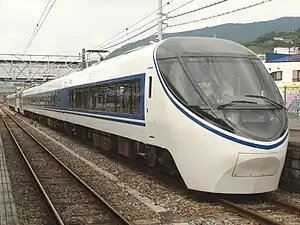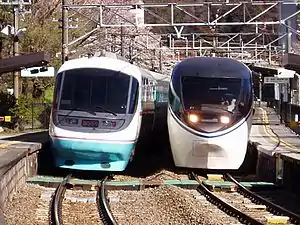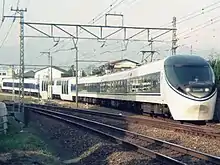371 series
The 371 series (371系電車) is an electric multiple unit (EMU) train operated by Central Japan Railway Company (JR Central) in Japan between 1991 and 2014. Originally used on Asagiri limited express services in conjunction with Odakyu Electric Railway,[1] from 2012 until its withdrawal in 2014, the train was used on Gotemba Line excursion services. It was subsequently sold to the private railway operator Fuji Kyuko and rebuilt as the Fujikyu 8500 series for use on Fujisan Tokkyu services from March 2016.
| 371 series | |
|---|---|
 371 series on an Asagiri service, October 2009 | |
| In service | March 1991 – November 2014 |
| Manufacturer | Hitachi, Kawasaki Heavy Industries, Nippon Sharyo |
| Number built | 7 vehicles (1 set) |
| Formation | 7 cars |
| Fleet numbers | X1 |
| Operator(s) | JR Central |
| Depot(s) | Shizuoka |
| Specifications | |
| Car body construction | Steel |
| Car length | 21.250 m (69 ft 9 in) (end cars) 20.000 m (65 ft 7 in) (intermediate cars) |
| Width | 2,900 mm (9 ft 6 in) |
| Doors | Sliding plug doors (1 per side) |
| Maximum speed | 120 km/h (75 mph) |
| Traction system | Resistor control + field system superimposed field excitation control |
| Electric system(s) | 1,500 V DC |
| Current collector(s) | C-PS27A single-arm pantograph |
| Safety system(s) | ATS-PT |
| Track gauge | 1,067 mm (3 ft 6 in) |
Design
The lone 7-car 371 series set was built jointly by Hitachi, Kawasaki Heavy Industries, and Nippon Sharyo.[2]
Operations

From its introduction on 16 March 1991 until 16 March 2012, the 371 series set was used alongside the two Odakyu 20000 series RSE EMUs on Asagiri services run jointly by the private railway operator Odakyu Electric Railway and JR Central between Odakyu's Tokyo terminus at Shinjuku and JR Central's Numazu Station in Shizuoka Prefecture via the Gotemba Line. In addition to the daytime Asagiri services, the train was also used on the following "Home Liner" limited-stop commuter services.[3]
- Home Liner Numazu
- Home Liner Hamamatsu
- Home Liner Shizuoka
From 17 March, the 371 series and 20000 series trains were replaced by Odakyu 60000 series MSE EMUs on Asagiri" services.
From June 2012, the 371 series set was used on additional limited-stop "Rapid" services on the Gotemba Line connected with a series of hiking events.[4]
Formation
The one 7-car set, X1, was formed as follows.[3] The two Green (first class) cars, 3 and 4, were bilevel cars.[1]
| Car No. | 1 | 2 | 3 | 4 | 5 | 6 | 7 |
|---|---|---|---|---|---|---|---|
| Designation | Mc | M' | ThsD | ThsD | M | M' | Mc |
| Numbering | KuMoHa 371-101 | MoHa 370-101 | SaRoHa 371-101 | SaRoHa 371-1 | MoHa 371-201 | MoHa 370-1 | KuMoHa 371-1 |
Cars 1, 5, and 7 are each fitted with one C-PS27A single-arm pantograph.[1]
 KuMoHa 371-101
KuMoHa 371-101 MoHa 370-101
MoHa 370-101 SaRoHa 371-101
SaRoHa 371-101 SaRoHa 371-1
SaRoHa 371-1 MoHa 371-201
MoHa 371-201 MoHa 370-1
MoHa 370-1 KuMoHa 371-1
KuMoHa 371-1
Interior
Standard class cars had regular 2+2 seating. The two bilevel cars had Green (first class) accommodation on the upper decks with 2+1 seating, and standard-class accommodation on the lower decks, also with 2+1 seating.[1]
 Standard class car interior, February 2009
Standard class car interior, February 2009 Bilevel car upper deck (Green class) accommodation, February 2009
Bilevel car upper deck (Green class) accommodation, February 2009 Bilevel car lower deck (standard class) accommodation, February 2009
Bilevel car lower deck (standard class) accommodation, February 2009
History

The 371 series set entered service on 16 March 1991.[3] From 24 June 1997, car 7 was made no-smoking, and from 18 March 2007, all cars were made no-smoking.[3] From 6 November 2006, the original PS24A lozenge-type pantographs were replaced with C-PS27A single-arm pantographs.[1][3]
Withdrawal
The 371 series was withdrawn from Asagiri services following its last run on 16 March 2012. It was subsequently re-employed as a special charter train for use from autumn 2012.[5]
The train was finally withdrawn from service after a final run on 30 November 2014.[6]
Resale

In December 2014, it was announced that the private railway operator Fuji Kyuko planned to purchase the trainset, and reform it as a three-car set for use on Fujisan Tokkyu services later in fiscal 2015.[7] The train was moved from Shizuoka to JR East's Nagano Works for rebuilding work in March 2015.[8]
References
- Jēāru zensharyō handobukku: Rail Magazine 2009 JR全車輌ハンドブック2009 [JR Rolling Stock Handbook 2009]. Japan: Neko Publishing. 2009. pp. 163–164. ISBN 978-4-7770-0836-0.
- Saka, Masahiro (March 2014). JR第1世代の車両・現況と概要 [JR 1st-generation rolling stock: Current situation and overview]. Tetsudō Daiya Jōhō Magazine (in Japanese). 43 (359): 22.
- JR電車編成表 2011夏 [JR EMU Formations - Summer 2011]. Japan: Kotsu Shimbunsha. May 2010. p. 117. ISBN 978-4-330-21211-1.
- JR東海371系 臨時快速に使用 [JR Central 371 series to be used on additional Rapid services]. Tetsudo Hobidas (in Japanese). Japan: Neko Publishing. 30 May 2012. Archived from the original on 2 March 2020. Retrieved 1 June 2012.
- 「371系」来春引退 JR東海の特急「あさぎり」 [JR Central 371 series Asagiri limited express to be withdrawn next spring]. @Shizuoka (in Japanese). Japan: The Shizuoka Shimbun and Shizuoka Broadcasting System. 18 October 2011. Archived from the original on 20 October 2011. Retrieved 2 December 2014.
- 「あさぎり号」などで活躍…371系ラストラン [Last run for the 371 series - formerly active on "Asagiri"]. Yomiuri Online (in Japanese). Japan: The Yomiuri Shimbun. 1 December 2014. Archived from the original on 2 December 2014. Retrieved 2 December 2014.
- 富士急行,JR東海371系を購入 [Fuji Kyuko to purchase JR Central 371 series]. Japan Railfan Magazine Online (in Japanese). Japan: Koyusha Co., Ltd. 16 December 2014. Retrieved 16 December 2014.
- 371系7輌 長野へ輸送される [371 series 7 cars moved to Nagano]. RM News (in Japanese). Japan: Neko Publishing Co., Ltd. 30 March 2015. Archived from the original on 11 March 2017. Retrieved 30 March 2015.
External links
- JR Central 371 series information (in Japanese)
